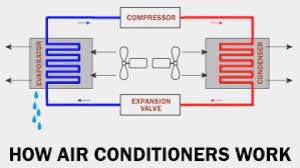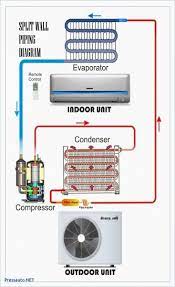Introduction:
In the realm where thermodynamics meets fluid dynamics and control theory, we’re about to uncover the symphony of engineering brilliance that turns stifling heat into a refreshing breeze. So, grab your virtual engineering toolkit as we dissect the components of air conditioning systems, unveiling the secrets behind their cooling wonders. From the rhythmic hum of compressors to the dance of refrigerants, let’s explore the technical marvels that how a window air conditioner works. Welcome to the engineering symphony of air conditioners!

-
Compressor: The Vapor Compression Cycle Maestro
The compressor is like the heart of the air conditioner. It pumps a special fluid called refrigerant, which helps move the heat out of the room. The compressor squeezes the refrigerant, making it really hot and high in pressure. This process is important because it helps the air conditioner work better at cooling.
Example: Think of a Scroll Compressor, which is a type of compressor that works quietly and efficiently, making sure your room stays cool.

-
Evaporator Coil: Heat Absorption and Latent Heat
The evaporator coil is like a magic sponge that absorbs the heat from the room. As the refrigerant flows through this coil, it turns from a liquid into a gas, which helps it soak up heat. This process cools the air that gets blown back into the room.
Example: A refrigerant called R-410A is often used because it’s great at changing from a liquid to a gas and back, making the cooling process super effective.
https://www.youtube.com/watch?v=p6GXJdRUz9E

-
Condenser Coil: Heat Rejection and Enthalpy
The condenser coil is where the refrigerant, now full of heat, releases that heat outside. The refrigerant cools down and turns back into a liquid, ready to start the cooling process all over again.
Example: Some air conditioners use microchannel condenser coils, which are really good at getting rid of heat and helping the system use less energy.

-
Expansion Valve: Throttling Process and Subcooling
The expansion valve is like a gatekeeper for the refrigerant. It controls how much refrigerant flows through the system. This valve helps keep everything balanced so the air conditioner can work efficiently and keep the refrigerant cool.
Example: A Thermostatic Expansion Valve (TXV) is a common type that makes sure the right amount of refrigerant flows through, based on how hot or cold it is.

-
Fan Dynamics: Centrifugal Fans and Aerodynamic Analysis
The fans in the air conditioner help move the air through the system. They push the warm air from the room over the cold evaporator coils and blow the cooled air back into the room.
Example: Fans with forward-curved blades are often used because they are good at moving a lot of air quickly, which helps cool down the room faster.

-
Refrigerant Science: Thermodynamic Properties and Eco-Friendly Alternatives
Refrigerants are the special fluids that carry heat around in the air conditioner. They have certain properties that make them really good at changing from a liquid to a gas and back again, which is key to the cooling process.
Example: R-1234yf is a newer refrigerant that’s better for the environment because it doesn’t harm the ozone layer as much as older refrigerants.

-
Thermostat Logic: PID Controllers and Smart Thermostats
The thermostat is like the air conditioner’s brain. It tells the system when to start cooling and when to stop. Some thermostats are really smart and can learn your habits to keep your home at just the right temperature without wasting energy.
Example: The Nest Learning Thermostat is an example of a smart thermostat that learns when you like it cool and adjusts the temperature automatically.

-
Air Filter Engineering: Filtration Efficiency and MERV Ratings
Air filters in the air conditioner trap dust, pollen, and other tiny particles, making sure the air you breathe is clean. The better the filter, the smaller the particles it can catch.
Example: HEPA filters are some of the best out there, catching tiny particles and keeping the air really clean.
Conclusion:
Air conditioners are amazing machines that use principles from science, like thermodynamics, to keep us cool and comfortable. By understanding how these different parts work together, we can appreciate the engineering behind them. Whether you’re dreaming of becoming an engineer or just curious about how things work, the world of air conditioning is full of fascinating science and technology. So, stay cool, keep learning, and maybe one day, you’ll invent the next great thing in air conditioning!
References:
“Thermodynamics: An Engineering Approach” by Yunus A. Çengel and Michael A. Boles
“Engineering Thermodynamics” by P.K. Nag
https://www.youtube.com/watch?v=6OU7WHgJ_cY

